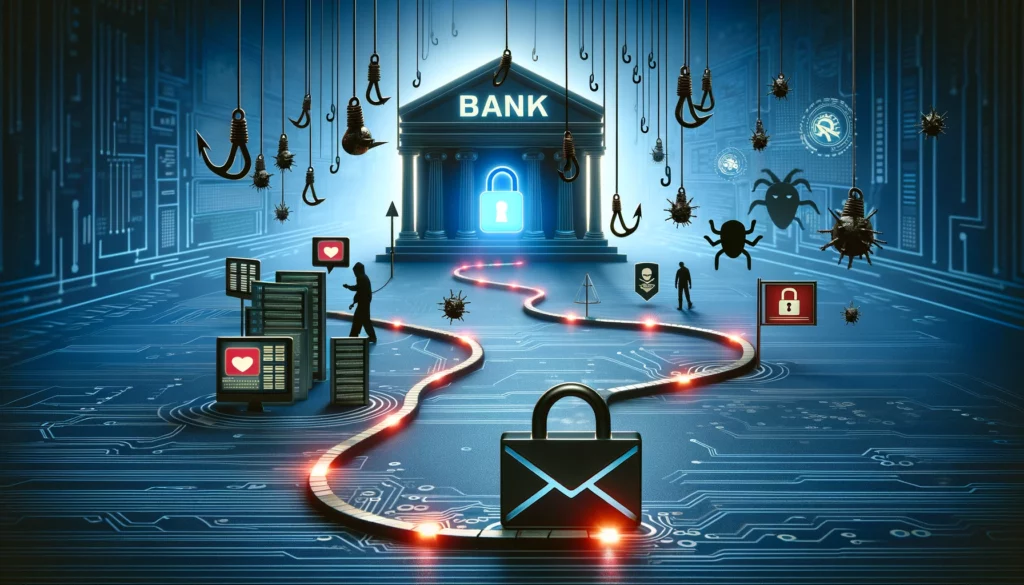Banking transactions have indeed undergone a remarkable transformation with the advent of technology. The ubiquity of smartphones, tablets, and computers has ushered in an era where managing finances is no longer confined to brick-and-mortar branches but is now at our fingertips, anytime and anywhere. From checking account balances to transferring funds and paying bills, the convenience offered by digital banking is unparalleled. However, alongside this convenience, we must recognize the importance of safeguarding our devices.
Our smartphones, tablets, and computers are not just tools for accessing financial services; they are repositories of sensitive information—passwords, account numbers, and personal details—that cybercriminals seek to exploit. Therefore, as we embrace the convenience of digital banking, we must also embrace the responsibility of securing our devices against evolving cyber threats. In this article, we’ll delve into why device security is crucial for safe banking transactions and provide actionable tips to fortify the defenses of your digital devices, ensuring the safety and integrity of your financial information.
Why Device Security Matters for Banking Transactions
Protection Against Malware
Protection against malware is a critical aspect of device security, especially concerning banking transactions. Malware encompasses a broad category of malicious software designed to infiltrate, damage, or gain unauthorized access to computer systems and devices. Among the various types of malware, viruses, trojans, and spyware pose significant threats to the security of our devices and the confidentiality of our sensitive information.
Viruses are malicious programs that replicate themselves and spread from one computer to another, often by attaching themselves to legitimate files or programs. Once a device is infected with a virus, it can wreak havoc on the system, causing data loss, system crashes, and unauthorized access to sensitive information. In the context of banking transactions, viruses can intercept and capture keystrokes, enabling cybercriminals to steal banking credentials and personal data entered by users.
Trojans, named after the mythical Trojan Horse, disguise themselves as legitimate software to trick users into downloading and installing them. Once installed on a device, trojans can perform a variety of malicious actions, including stealing sensitive information, logging keystrokes, and providing backdoor access for cybercriminals. In the context of banking, trojans can capture login credentials and financial data entered by users, allowing attackers to conduct unauthorized transactions and commit fraud.
Spyware is another type of malware that secretly monitors and gathers information about a user’s activities without their knowledge or consent. This information can include browsing habits, keystrokes, login credentials, and personal data. In the context of banking transactions, spyware can capture sensitive information entered by users, such as account numbers, passwords, and security codes, and relay it to cybercriminals for exploitation.
The consequences of malware infections can be severe, ranging from financial loss and identity theft to reputational damage and legal repercussions. Therefore, protecting against malware is crucial for safeguarding the security of our devices and the confidentiality of our banking transactions. This involves adopting proactive measures such as using reputable antivirus and antimalware software, keeping devices and software updated with the latest security patches, and exercising caution when downloading and installing apps or clicking on links from unknown sources. By taking these precautions, users can reduce the risk of malware infections and mitigate the potential impact on their financial security and privacy.
Prevention of Unauthorized Access
Prevention of unauthorized access is a fundamental aspect of device security, especially concerning banking applications and accounts. Implementing robust authentication mechanisms helps safeguard sensitive financial information and reduces the risk of identity theft and financial fraud.
Strong Passwords: Utilizing strong, complex passwords is an essential first line of defense against unauthorized access to banking apps and accounts. Strong passwords typically consist of a combination of letters (both uppercase and lowercase), numbers, and special characters. They should be unique for each account and not easily guessable. By creating strong passwords, users make it significantly more difficult for cybercriminals to gain unauthorized access to their accounts through brute-force attacks or password guessing techniques.
Biometric Authentication: Biometric authentication methods, such as fingerprint scanning, facial recognition, or iris scanning, provide an additional layer of security beyond traditional password-based authentication. These biometric identifiers are unique to each individual and are difficult to replicate, enhancing the security of banking apps and accounts. Biometric authentication adds convenience for users while also increasing the difficulty for unauthorized individuals to access sensitive financial information.
Other Security Measures: In addition to strong passwords and biometric authentication, there are other security measures that can further bolster the protection of banking apps and accounts. These may include multi-factor authentication (MFA), which requires users to provide multiple forms of verification before gaining access to their accounts. For example, in addition to entering a password, users may need to enter a one-time code sent to their mobile device or generated by an authentication app. Other security measures may include device encryption, remote wipe capabilities in case of loss or theft, and app sandboxing to isolate sensitive data from other apps on the device.
By implementing these security measures, users can significantly reduce the risk of unauthorized access to their banking apps and accounts. This not only protects their financial information but also safeguards their identity and privacy. Furthermore, financial institutions often require or recommend these security measures to ensure compliance with regulatory standards and protect both their customers and their own reputation from the consequences of security breaches. Ultimately, the prevention of unauthorized access is a crucial aspect of device security that enhances the overall security posture of banking transactions.
Safe Online Banking Experience
A safe online banking experience is contingent upon the security of the devices used to access banking services. A secure device serves as the foundation for protecting sensitive financial information from interception and exploitation by cybercriminals, thereby ensuring the integrity and confidentiality of online banking transactions.
A secure device creates a safe environment by employing various security measures to mitigate the risks associated with online banking:
- Data Encryption: Secure devices utilize encryption techniques to encode sensitive data transmitted between the device and banking servers. Encryption scrambles the information into an unreadable format, making it virtually impossible for cybercriminals to intercept and decipher the data as it traverses the internet. This ensures that banking transactions remain confidential and protected from eavesdropping or interception by unauthorized parties.
- Secure Communication Protocols: Secure devices leverage robust communication protocols, such as HTTPS (Hypertext Transfer Protocol Secure), to establish encrypted connections with banking servers. HTTPS encrypts data exchanged between the device and servers, providing an additional layer of protection against unauthorized access and data tampering during transit. By utilizing secure communication protocols, devices can thwart man-in-the-middle attacks and safeguard the integrity of online banking transactions.
- Multi-Layered Authentication: Secure devices implement multi-layered authentication mechanisms to verify the identity of users and prevent unauthorized access to banking accounts. Multi-factor authentication (MFA) requires users to provide multiple forms of verification, such as passwords, biometric identifiers, or one-time codes, before granting access to their accounts. This multi-layered approach enhances security by adding additional barriers to unauthorized access and reducing the likelihood of account compromise due to password theft or brute-force attacks.
- Regular Security Updates: Secure devices prioritize the timely installation of security updates and patches to address known vulnerabilities and protect against emerging threats. Operating system updates, application patches, and security software updates help fortify the device’s defenses against malware, exploits, and other cyber threats. By keeping devices up-to-date, users ensure that their devices remain resilient to security vulnerabilities that could be exploited by cybercriminals to compromise the safety of online banking transactions.
- Vigilant Monitoring and Detection: Secure devices employ proactive monitoring and detection mechanisms to identify suspicious activities or unauthorized access attempts in real-time. Intrusion detection systems, anti-malware software, and behavioral analytics tools continuously monitor device activity for signs of compromise or malicious behavior. Prompt detection enables users to take immediate action to mitigate potential threats and protect the integrity of their online banking transactions.
- Use Strong Passwords: Protect your devices with strong, unique passwords or passphrases to prevent unauthorized access. Avoid using easily guessable passwords like “password123” and consider enabling biometric authentication, such as fingerprint or facial recognition, for added security
- Use Antivirus and Antimalware Software: Install reputable antivirus and antimalware software on your devices to detect and remove malicious software that could compromise your security. Schedule regular scans and ensure real-time protection is enabled to safeguard against threats in real-time.
- Be Cautious of App Permissions: Before downloading and installing mobile banking apps or any other apps on your device, review the permissions requested by the app. Be wary of apps that request excessive permissions or access to sensitive information unrelated to their functionality.
- Secure Your Network: Secure your home Wi-Fi network with a strong password and encryption to prevent unauthorized access by hackers. Avoid connecting to public Wi-Fi networks when conducting sensitive banking transactions, as they may not be secure.
By providing a secure environment for conducting online banking transactions, secure devices enable users to confidently manage their finances while mitigating the risks posed by cyber threats. A safe online banking experience hinges on the security of devices, which serves as the frontline defense against interception, exploitation, and unauthorized access by cybercriminals. By implementing robust security measures and staying vigilant, users can safeguard their financial information and enjoy a secure online banking experience.
Regularly Monitor Your Accounts
Review Account Activity
Regularly reviewing account activity is a fundamental practice for ensuring the security of banking transactions and protecting against unauthorized access or fraudulent activity. By actively monitoring bank accounts and credit card statements, individuals can detect any irregularities or suspicious transactions promptly, allowing them to take immediate action to mitigate potential risks and prevent further fraud.
Reviewing account activity involves systematically examining transaction histories, statements, and alerts provided by financial institutions to identify any discrepancies or unauthorized charges. Here’s why this practice is essential:
- Early Detection of Fraudulent Activity: Regularly reviewing account activity enables individuals to detect fraudulent transactions or unauthorized access to their accounts at an early stage. By scrutinizing transaction details and identifying any unfamiliar or suspicious charges, individuals can promptly report such incidents to their bank or credit card issuer, mitigating the risk of financial loss and minimizing the impact of fraudulent activity.
- Prevention of Further Fraud: Promptly reporting unauthorized transactions or suspicious activity to the bank or credit card issuer helps prevent further fraud and unauthorized access to accounts. Financial institutions can take immediate action, such as freezing the account, canceling compromised cards, or initiating investigations to identify the perpetrators and recover any stolen funds. Timely reporting also allows banks to implement additional security measures to protect the account from future unauthorized access or fraudulent activity.
- Protection Against Identity Theft: Monitoring account activity regularly is crucial for detecting signs of identity theft, such as unauthorized account openings, changes in personal information, or unusual account behavior. By staying vigilant and reviewing account statements and alerts, individuals can identify potential instances of identity theft and take appropriate steps to safeguard their personal information and financial assets.
- Compliance with Regulatory Requirements: Many financial regulations and consumer protection laws require individuals to monitor their account activity for fraudulent transactions and report any discrepancies in a timely manner. By adhering to these regulatory requirements, individuals not only protect themselves from financial loss but also contribute to maintaining the integrity and security of the overall banking system.
To effectively review account activity, individuals should:
- Regularly review bank account and credit card statements, preferably on a monthly basis or more frequently if possible.
- Scrutinize transaction details, including dates, amounts, merchants, and locations, to identify any unauthorized or unfamiliar charges.
- Set up account alerts or notifications to receive real-time alerts for large transactions, unusual account activity, or changes to account settings.
- Report any discrepancies, suspicious transactions, or unauthorized access to the bank or credit card issuer immediately, following their specific reporting procedures.
Regularly reviewing account activity is a proactive measure that individuals can take to protect their financial assets, detect fraudulent activity, and safeguard against unauthorized access to their accounts. By staying vigilant and promptly reporting any discrepancies or suspicious transactions, individuals can play a crucial role in preventing fraud, minimizing financial losses, and maintaining the security of their banking transactions.
Set Up Account Alerts
Setting up account alerts is a proactive strategy that individuals can utilize to enhance the security of their banking transactions and promptly identify any suspicious or unauthorized activity. These alerts, provided by banks and financial institutions, notify account holders of specific account activities or events in real-time, enabling them to stay informed and take immediate action to mitigate potential risks. Here’s why setting up account alerts is crucial:
- Timely Detection of Suspicious Activity: Account alerts allow individuals to receive notifications for various types of account activity, such as large transactions, unusual spending patterns, or account logins from unfamiliar devices. By promptly receiving alerts for these activities, individuals can quickly identify any suspicious or unauthorized transactions and take appropriate measures to address them.
- Immediate Response to Potential Threats: With account alerts in place, individuals can respond promptly to potential threats or security breaches, such as unauthorized access to their accounts or fraudulent transactions. Upon receiving an alert for suspicious activity, individuals can take immediate action, such as contacting their bank to report the incident, freezing the account, or initiating additional security measures to protect their financial assets.
- Enhanced Security and Fraud Prevention: Account alerts serve as an additional layer of security and fraud prevention, helping individuals detect and prevent fraudulent activity before it escalates. By monitoring account activity in real-time and receiving alerts for unusual or unauthorized transactions, individuals can proactively safeguard their accounts against fraudulent access or unauthorized use, minimizing the risk of financial loss and identity theft.
- Customization and Flexibility: Most banks offer customizable account alert options, allowing individuals to tailor their alerts based on their specific preferences and security needs. Individuals can choose the types of account activities they want to be alerted about, set notification thresholds for transaction amounts, and select their preferred delivery method for receiving alerts, such as email, text message, or push notification through the bank’s mobile app.
To effectively leverage account alerts, individuals should:
- Review the alert options provided by their bank and select the alerts that align with their security preferences and monitoring requirements.
- Set up alerts for critical account activities, such as large transactions, account logins from new or unrecognized devices, and unusual spending patterns.
- Regularly review and monitor alert notifications received from their bank, paying close attention to any alerts indicating potentially fraudulent or suspicious activity.
- Take immediate action upon receiving alerts for suspicious activity, such as contacting their bank’s fraud department, reporting the incident, and implementing additional security measures to protect their accounts.
Setting up account alerts is a proactive security measure that empowers individuals to monitor their account activity in real-time, detect potential threats or fraudulent activity promptly, and take immediate action to safeguard their financial assets. By leveraging account alerts effectively, individuals can enhance the security of their banking transactions and mitigate the risk of financial loss or identity theft.
Conclusion
Securing your devices is not merely a recommendation but a necessity for safe banking transactions in today’s digital landscape. As we increasingly rely on technology to manage our finances, the security of our devices becomes paramount to protect our sensitive financial information from cyber threats. By adhering to practical tips and best practices for device security, individuals can fortify their defenses against malicious actors and ensure a secure online banking experience.
Implementing robust device security measures is the cornerstone of safeguarding financial information and preserving the integrity of banking transactions. Whether it’s using strong passwords, enabling biometric authentication, or keeping software updated, each step contributes to strengthening the overall security posture of devices. These proactive measures not only mitigate the risk of unauthorized access but also thwart potential cyber threats, such as malware infections, phishing attacks, and identity theft.
Furthermore, investing in device security is an investment in safeguarding one’s financial well-being. The consequences of a security breach or compromise can be severe, resulting in financial loss, identity theft, and reputational damage. By prioritizing device security, individuals can mitigate these risks and protect their financial assets from exploitation by cybercriminals.
Moreover, securing devices goes beyond personal protection—it also contributes to the overall security of the digital ecosystem. By ensuring that devices remain secure and resilient against cyber threats, individuals play a vital role in safeguarding the integrity of online banking systems and protecting the broader community from potential vulnerabilities and attacks.
In conclusion, securing devices is imperative for safe banking transactions in today’s digital world. By following practical tips and best practices for device security, individuals can protect their financial information, mitigate the risk of cyber threats, and enjoy a secure online banking experience. Remember, investing in device security is not only an investment in personal safety but also a proactive measure to safeguard one’s financial well-being and contribute to the collective security of the digital landscape.

Penetra Cybersecurity is at the forefront of defending the digital frontier, providing cutting-edge solutions to protect businesses and organizations from the ever-evolving threats of the cyber world. Established with a mission to create a safer internet for everyone, Penetra leverages a blend of advanced technology, expert knowledge, and proactive strategies to stay ahead of cybercriminals.
Ready to take the next step towards a more secure future? Schedule a consultation with us today and discover how we can help protect what matters most to you. Don’t wait until it’s too late—with Penetra Cybersecurity, your business isn’t just secure; it’s imPenetrable.




